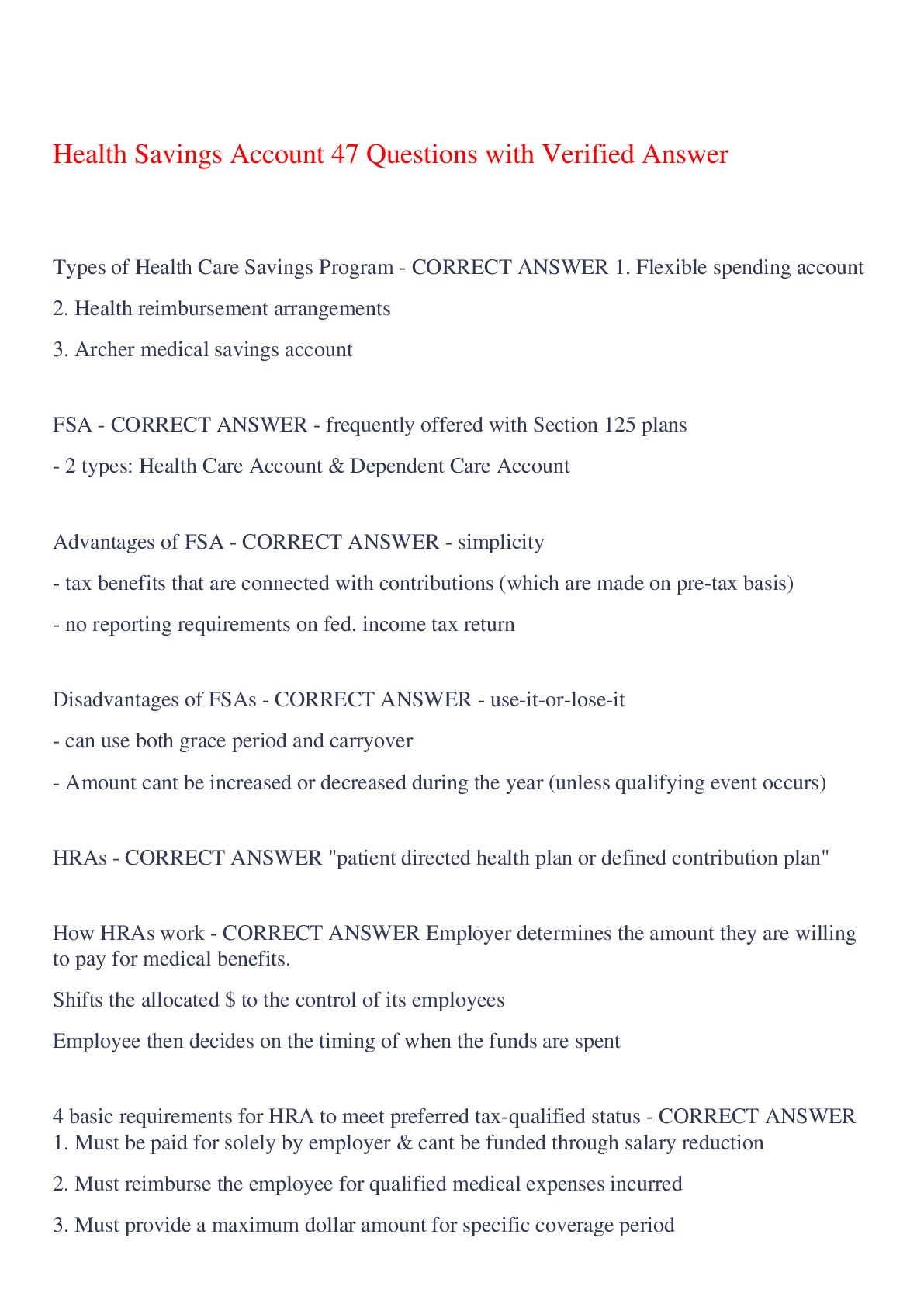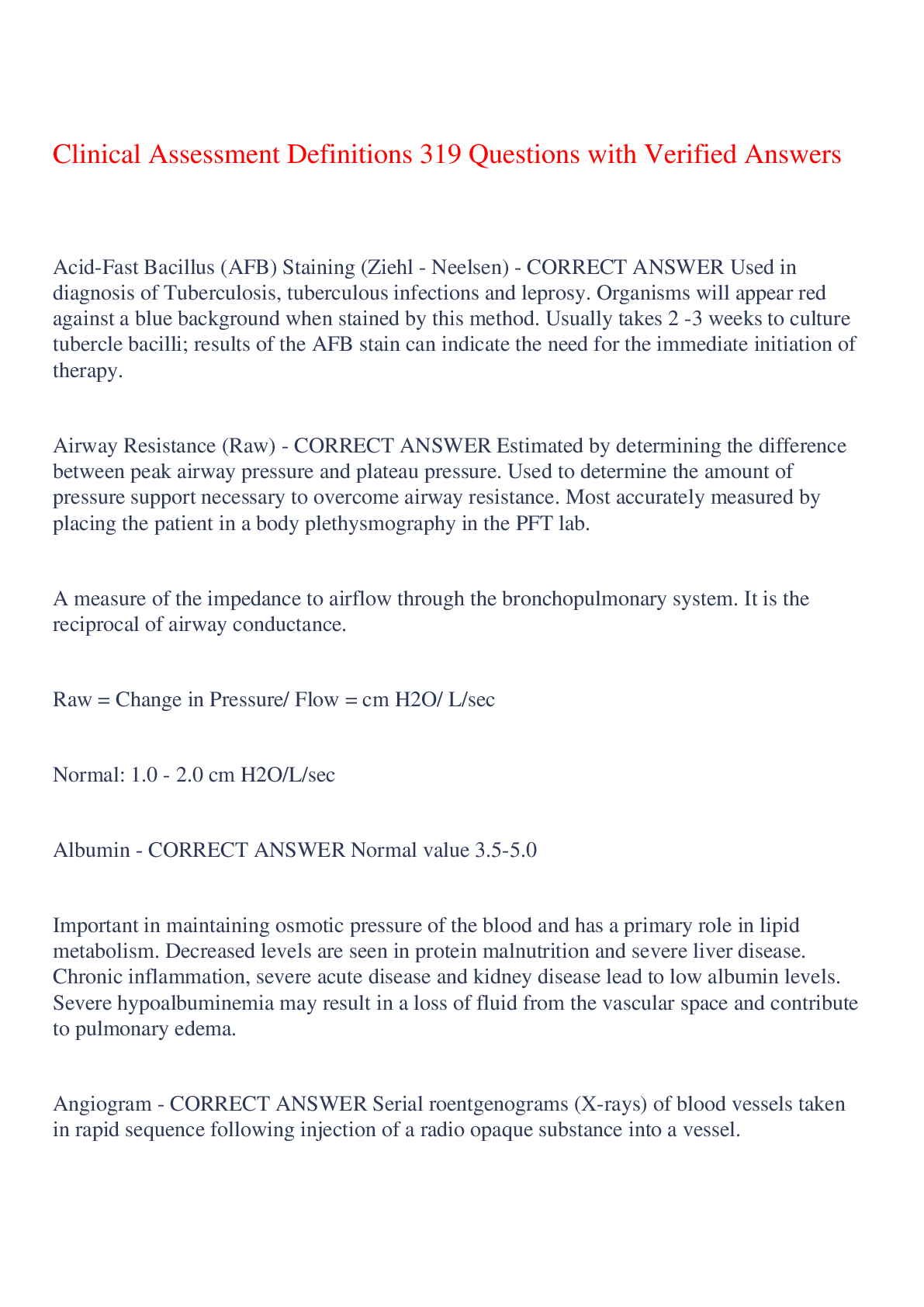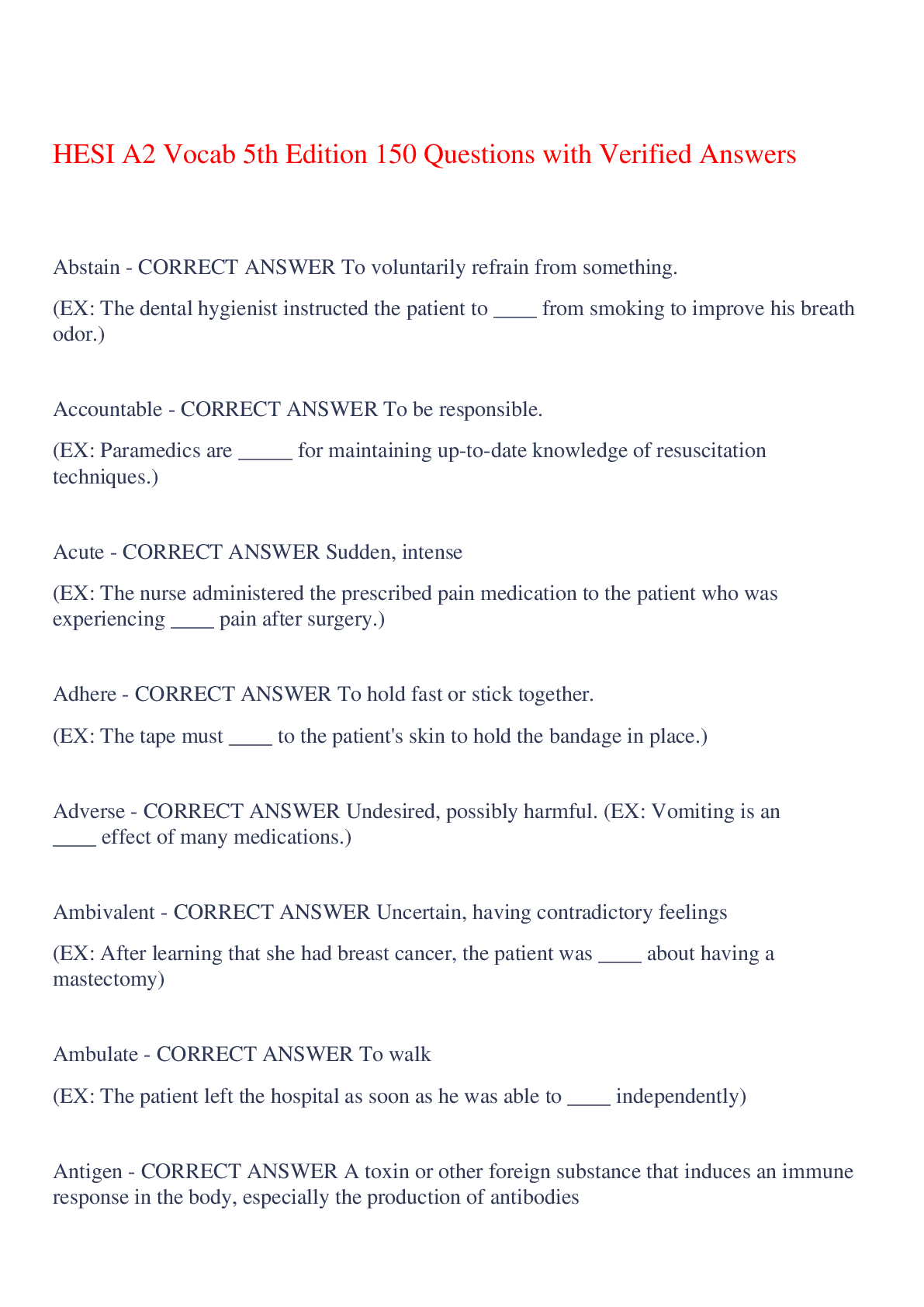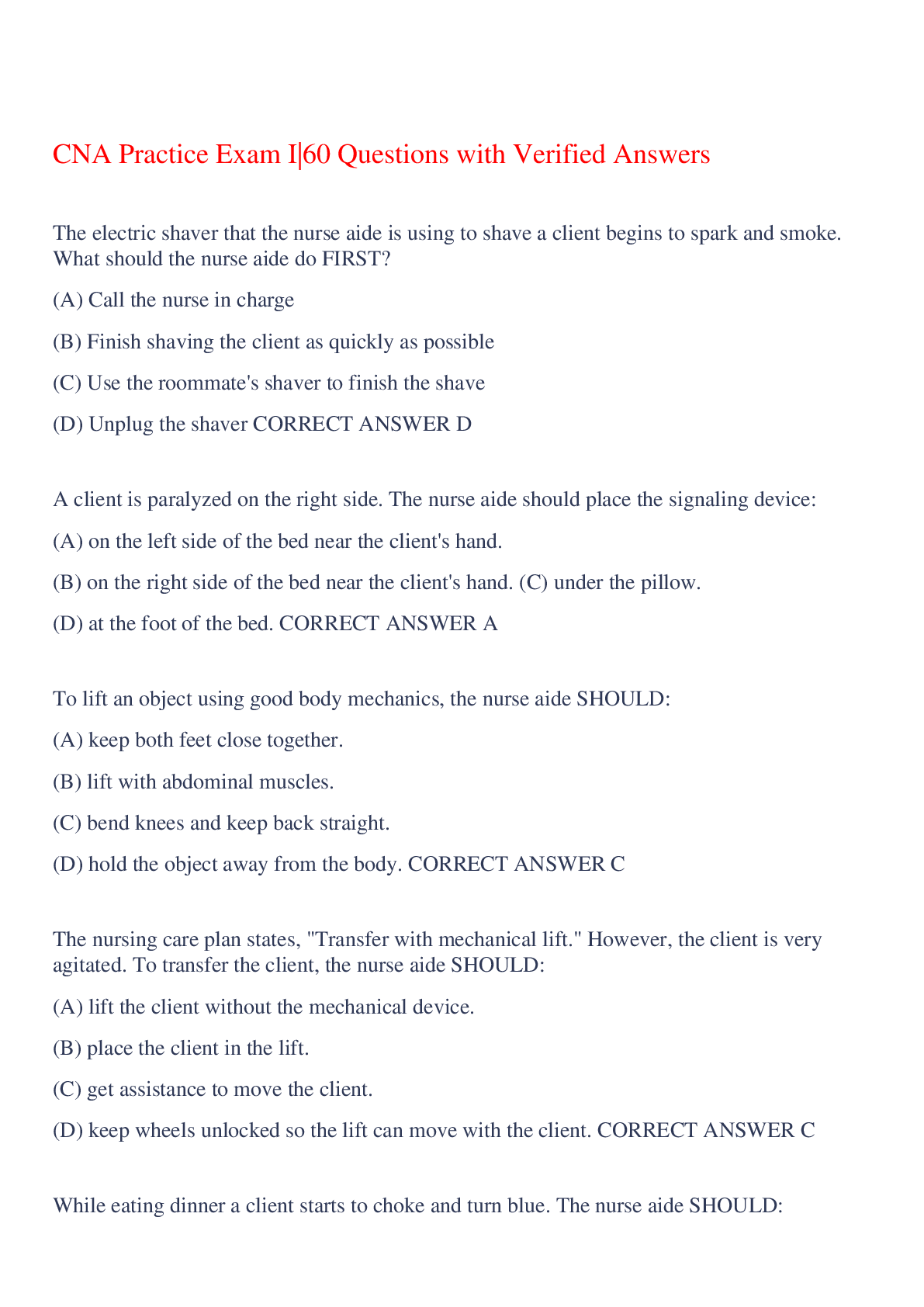*NURSING > EXAM > Primary Care Adult 1 NP Exam 1|148 Questions with Verified Answers,100% CORRECT (All)
Primary Care Adult 1 NP Exam 1|148 Questions with Verified Answers,100% CORRECT
Document Content and Description Below
Primary Care Adult 1 NP Exam 1|148 Questions with Verified Answers When does chronic disease present? - CORRECT ANSWER between 40 to 65 primary prevention - CORRECT ANSWER immunization, educat... ion, cancer prevention, weight control, seat belt, violence prevention, substance abuse secondary prevention - CORRECT ANSWER screening tertiary prevention - CORRECT ANSWER rehabilitation, preventing further problems how often do you need a tdap booster - CORRECT ANSWER every 10 years when should you receive shingles vaccine - CORRECT ANSWER 60 when should you receive the pneumococcal vaccine - CORRECT ANSWER 65 ten leading causes of death - CORRECT ANSWER heart disease, cancer, chronic lower respiratory disease, stroke, accidents, alzheimer's diabetes, influenza & pneumonia, kidney disease, self-harm/suicide prevalance - CORRECT ANSWER number of cases of a disease at a point in time divided by the percent of the population indcidence rate - CORRECT ANSWER number of NEW cases morbidity - CORRECT ANSWER number of poeple diagnosed with disease divided by total population of risk ex. number of people living with AIDS mortality - CORRECT ANSWER number of people who have died sporadic - CORRECT ANSWER outbreaks i.e. stomach virus epidemic - CORRECT ANSWER flu endemic - CORRECT ANSWER constantly present i.e. common cold OLDCARTS - CORRECT ANSWER onset, location, duration, characteristics, aggravators, relievers, treatment SOAP - CORRECT ANSWER subjective, objective, assessment, plan confusion - CORRECT ANSWER inability to think quickly or coherently; disoriented to time, place or place; impaired cognitive functinoing and inappropriate reactions aphasia - CORRECT ANSWER loss of ability to express or understand speech apraxia - CORRECT ANSWER trouble finding words agnosia - CORRECT ANSWER inability to recognize antipsychotics for confusion - CORRECT ANSWER Haldol, seroquel, risperdal, zyprexa, abilify control impulsivity and aggression in confusion - CORRECT ANSWER anticonvulsants - tegretol panic disorders - CORRECT ANSWER ativan dizziness - CORRECT ANSWER unsteadiness and feeling of movement within the head vertigo - CORRECT ANSWER rotation or movement of surroundings peripheral vestibular disease - CORRECT ANSWER most common cause of dizziness and vertigo; labryinth of middle ear peripheral vestibular disease s/s - CORRECT ANSWER dizzy, n/v, diaphoresis, unbalanced, vertigo, tinnitus, hearing loss, diplopia peripheral vestibular disease treatment - CORRECT ANSWER antihistamines; take for 1 week then taper muscle contraction/tension headache - CORRECT ANSWER most common; young adults & females paresthesia - CORRECT ANSWER abnormal sensation described as numbness or tingling, cramping, or pain without know stimulus "pins and needles" paresis - CORRECT ANSWER weakness paresis causes - CORRECT ANSWER arterial occlusion, arteriosclerosis obliterans, nerve entrapment syndrome, neuropathy, TIA, herpes zoster arterial occlusion - CORRECT ANSWER immediate embolectomy within 4-6 hours, surgical emergency arteriosclerosis obliterans - CORRECT ANSWER diminished or decreased blood flow to legs tremors - CORRECT ANSWER involuntary muscle movements resting tremor - CORRECT ANSWER occurs in relaxed position and ends with purposeful movement intentional tremor - CORRECT ANSWER when patient attempts to make purposeful movement epilepsy - CORRECT ANSWER 2 or more recurrent seizures because of CNS disorder seizure - CORRECT ANSWER sudden, involuntary, time-limited alteration in behavior clonic seizure - CORRECT ANSWER maximal contraction of muscles repeated 3 times a second simple partial seizure - CORRECT ANSWER no loss of consciousness, unilateral hemisphere complex partial seizure - CORRECT ANSWER consciousness impaired, bilateral hemispheres automatisms - CORRECT ANSWER eating, mimicry, expressing emotional state, gestures, crude behavior generalized seizure - CORRECT ANSWER first clinical sign indicates both hemispheres, consciousness may be impaired and first s/s; motor manifestations may be bilateral absence seizure - CORRECT ANSWER hallmark is sudden onset, interruption of activities, blank stare, brief upward rolling of eyes tonic-clonic (Grand mal) - CORRECT ANSWER MOST COMMON GENERALIZED; sudden sharp contraction of muscles, stridor or cry and will fall to ground; lies rigid, respiration inhibited, cyanpsos, tongue may be bitten, may void urine, clonic = convulsions; at the end will remain unconscious and wake with a headache after deep sleep seizure epidemiology - CORRECT ANSWER present before 5, men >women antieleptics - CORRECT ANSWER dilantin, tegretol, lamictal reduce hyperexcitability seizure GABA agonists - CORRECT ANSWER counteract tendency to have seizures valium avoid gabapentin and lyrica seizure diagnostics - CORRECT ANSWER EEG, MRI, CT seizure management - CORRECT ANSWER check blood levels 2-3 times in first 6 months partial seizures may appear as intoxication Valproic acid - CORRECT ANSWER 50-100 mcg/ml is optimal level; take with food; AR - n/v, indigestion, diarrhea, anorexia, depression, hair loss absence seizures and myoclonic divalproex sodium (Depakote) - CORRECT ANSWER take with food, may cause headache, unsteadiness clonazepam (Klonopin) - CORRECT ANSWER optimum level 20-80 mg/ml; potenetiates CNS depression with alcohol phenytoin (Dilantin) - CORRECT ANSWER partial or generalized seizure; optimum level 10-20 mcg/ml; AR - ataxia, peripheral neuropathy topiramate (topamax) - CORRECT ANSWER may cause hyponatremia, weight loss, mental fuzziness, stimulation oxcarbazepine (trileptal) - CORRECT ANSWER partial seizure; potentiates CNS depression with alcohol ALS/Lou Gehrig's disease - CORRECT ANSWER destruction of anterior horn motor cell in spinal cord or brainstem; fatal; live 5-6 years after diagnosis ALS s/s - CORRECT ANSWER SYMMETRICAL; present with gait disturbance caused by weakness or change in voice ALS diagnosis - CORRECT ANSWER electromyographical studies ALS treatment - CORRECT ANSWER none, fatal Multiple Scleoris (MS) - CORRECT ANSWER most common in young adults relapsing-remitting MS - CORRECT ANSWER acute attacks with full recovery and some residual between episodes primary progressive - CORRECT ANSWER steady progression with some plateaus and remission progressive-relapsing - CORRECT ANSWER progression with relapses and remission with or w/o recovery MS diagnosis - CORRECT ANSWER between 20 nd 50; women >men, whites, unknown cause MS s/s - CORRECT ANSWER spasticity, weakness of legs, bladder and bowel dysfunction, ataxic gait, paresthesia, fatigue, optic neuritis, trigeminal neuralgia INITIAL: blurred or double vision, red-green color distortion, blindness in one eye MS criteria for diagnosis - CORRECT ANSWER 2 or more parts of CNS involvement and signs of CNS dysfunction; must have 2+ episodes separated by 1 month or more and lasting >24 hours with recovery; lumbar puncture, MRI MS management - CORRECT ANSWER exacerbations - IV methylprednisone w/ or w/o oral prednisone taper no cure 1st line - glucocorticoids spasticity - baclofen, baclofen pump MS relapsing-remitting managemetn - CORRECT ANSWER interferon 1a or b, DMARD 1st 2nd natalizumab progressive MS - CORRECT ANSWER methotrexate parkinson's - CORRECT ANSWER mean onset is 57, men>women, neurodegenerative, unknown cause; tremor at rest, muscular rigidity, slow movement, difficulty maintaining steady posture Lewy bodies parkinson's s/s - CORRECT ANSWER tremor at rest - disappears with movement, pillrolling, cogwheeling, rigid, bradykinesia, flexed posture, loss of postural reflexes, freezing phenomenon, TRAP UNILATERAL S/S drooling, impaired swallow, dysphagia, mask like face, soft speech,s lurred speech, slow handwriting parkinson's diagnosis - CORRECT ANSWER MRI, trial of levodopa parkinson's management - CORRECT ANSWER expensive, 1st line - levodopa (Start with lowest dose) (carbidopa/levodopa 25/100 2 tabs daily) and trial for 3 months before changing may go up to 300-500 mg/day alzheimer's - CORRECT ANSWER progressive, insidious onset, slow progressive cognitive decline, inability to learn new information, impaired memory alzheimer's epidemiology - CORRECT ANSWER 65+, life expectancy between 60-70 is 7-10 year alzheimer's s/s - CORRECT ANSWER initial complaint of memory issues, get lost in familiar place, inability to complete ADLs, slow responses, anomia(difficulty finding words) alzheimer's management - CORRECT ANSWER treat anxiety and depression aggresively first line - cholinesterase inhibitors: donepezil (aricept) for mild to moderate AD; namenda (memantine) for mod to severe CVA - CORRECT ANSWER hemorrhage or ischemic hemorrhage CVA - CORRECT ANSWER ruptured aneurysm, arteriovenous malformation, HTN arteriolar disorder, amyloid deposition ischemic CVA - CORRECT ANSWER atherosclerosis, embolus, thrombus, hemorrhage, vasospasm CVA epidemiology - CORRECT ANSWER 3rd cause of death, AA, >55, HTN, cardiac disease,d iabetes, high chol, smoking, drug use, Afib, obesity, inactive, poor diet, stress cerebral ischemia - CORRECT ANSWER blood flow reduction that lasts more than 4 minutes TIA, arterial occlusions, hypoperfusion (vision loss first, decreased alertness) cerebral hemorrhage - epidural - CORRECT ANSWER severe head injury, most common in temporal area increased ICP causes decreased perfusion contralateral hemiparesis from pressure, becomes lethargic and drowsy leads to herniation - fatal cerebral hemorrhage - subdural - CORRECT ANSWER blunt trauma expand slowly, some self-limiting cerebral hemorrhage - subarachnoid - CORRECT ANSWER blood in CSF reveals, first s/s reflects location CVA s/s - CORRECT ANSWER emotinoal changes, cognitive changes, wekaness, numbness, paralysis of extremities, aphasia CVA diagnosis - CORRECT ANSWER MRI CVA management - CORRECT ANSWER thrombolytics in 3.5-4 hours after onset carotid endarterectomy for carotid stenosis - give aspirin 81 to 325 mg prior to surgery and for 2 months after initial management - ABCs and tissue oxygenation if hypertensive do not reduce abruptly tension headache - CORRECT ANSWER mild or moderate BILATEAL band like nonpulsating, tigthening pain NOT aggravated by activity no n/v or photophobia migraine - CORRECT ANSWER lasts 4-72 hours and may have aura pulsating, n/v, photophobia aggravated by activity cluster - CORRECT ANSWER occurs at night for 15 min to 3 hours severe UNILATERAL orbital or temporal pain same side of face sweating, lacrimination, ptosis, rhinorrhea traction or inflammatory headache - CORRECT ANSWER medical emergency migraine management - CORRECT ANSWER imitrex - sumatriptan cluster management - CORRECT ANSWER 100% oxygen meningitis - CORRECT ANSWER inflammation of meninges, abnormality in WBC in CSF meningitis causes - CORRECT ANSWER N. meningitis, H influenzae, Strep pneumoniae common in spring and fall usually with otisi media, epiglottis or meningitis N meningitidis - CORRECT ANSWER common age 2-18 S pneumonia - CORRECT ANSWER adults with pneumonia, sinusitis, otitis media, endocarditis S aureus - CORRECT ANSWER invasive procedures meningitis s/s - CORRECT ANSWER nuchal rigidity, fever, headache, vomiting, lethargy, confusion, coma, Brudniski's, Kernig's meningitis diagnosis - CORRECT ANSWER CSF, LP, MRI menigitis management - CORRECT ANSWER do not hold antibiotics for culture Cefotaxime IV 50 mg/kg or Ceftriaone 50-100 mg 10-14 days encephalitis - CORRECT ANSWER acute inflummation of brain tissue sually caused by virus common are HSV and arbovirus encephalitis s/s - CORRECT ANSWER fever, confusion, drowsiness progress to coma, abrupt onset, headache, seizure, nuchal rigidity, muscle weakness, hyperreflexive DTRs, viral rash encephalitis diagnosis - CORRECT ANSWER LP, increased in WBCs in CSF, MRI encephalitis management - CORRECT ANSWER hospitalization viral - acyclovir 10 mg/kg q8 x 21 days seizure control with Dilantin up to 60 mg/day HSV - foscavir 20 mgkg IV bolus then 120 mg/kg q8 microbial - PCN G 20 million units/day cerebral edema - mannitol, glucocorticoids trigeminal neuralgia - CORRECT ANSWER disorder of cranial nerve V (trigeminal); facial pain that lasts less than 3 seconds and occurs along 1 or more of the three brances triggered by touch, chewing, talking, shaving, temperature women>men, middle aged and eldery associated with HTN, and MS suicidal tendencies trigeminal neuralgia diagnosis - CORRECT ANSWER MRI trigeminal neuralgia management - CORRECT ANSWER 1st - carbamazepine 100 mg PO BID to block nerve firing bell's palsy - CORRECT ANSWER acute onset of flaccid paralysis, one side of face in otherwise healthy person self-limiting, complete recovery in months cranial nerve 7 - facial, preceded by viral infection (herpes) bell's palsy s/s - CORRECT ANSWER loss of taste, psotauricular pain, abnormal sensitivity to sound, heavy feeling in face bell's palsy management - CORRECT ANSWER recover w/o treatment, prevent eye injury and dry eye, acyclovir guillan-barre - CORRECT ANSWER ascending paralysis beginning in legs and progressing ataxia, dysphonia, dysphagia may be self-limiting or permanent diagnosed with CSF IV gamma globulin or plasmapharesis botulism - CORRECT ANSWER paralytic illness caused by Clostridium botulim, enters through infected wound or oral from not pasteurizing, raw honey or milk symptoms in 72 hours oftin requires vent myasthenia gravis - CORRECT ANSWER autoimmune women>men muscle fatigue with use - eyes and mouth symptomatic treatment with antihcolinesterase agents age related changes - CORRECT ANSWER kidney function declines in 4th decade; prolonged half life recommended blood pressure screening - CORRECT ANSWER every 2 years colorectal screening - CORRECT ANSWER >50 and every 10 years mammogram - CORRECT ANSWER >40 every 2 years MI - CORRECT ANSWER asprin men 45-79 and women 55-79 Tdap - CORRECT ANSWER every 10 years osteoporosis - CORRECT ANSWER women >65 pneumococcal - CORRECT ANSWER >65 every 5 years shingles - CORRECT ANSWER presyncope - CORRECT ANSWER feeling before you faint cerebellar disease - CORRECT ANSWER unable to stand with feet together decreased position sense - CORRECT ANSWER sway when eyes closed hallpike manuever - CORRECT ANSWER lower head over back of table and turn to side - if nystagmus, may be caused by vertigo herpes zoster - CORRECT ANSWER cuteaneous eruption of dermatome distribution, burning or tingling skin sensation contagious for 8-21 days age >55 women>men shingles s/s - CORRECT ANSWER hyperesthesia with burning or tingling pain at site 4-5 days before eruption, anxiety, malaise, headache, fever, flu-like s/s vesicles clear then cloudy in 3-5 days, become pustular and crust over common T5-T6, then cervical, then sacral common face and trunk pain lasts 6-12 months shingles management - CORRECT ANSWER acyclovir 800 mg 5x /day for 7-10 days give within 72 hours of onset f/u 2-4 weeks postherpatic neuralgia - CORRECT ANSWER pain persists at least 6 weeks after lesions gabapentin 300 mg and titrate up from day 1 lasts 1 year or less brain tumor s/s - CORRECT ANSWER headache w/ or w/o nausea and vomting, seizzure, change in mental status, motor or language deficits between 65 and 79, men>women, caucasians and hispanics brain tumor management - CORRECT ANSWER surgery, radiation, chemo, steroids, anticonvulsants f/u every 3 months plus MRI peripheral neuropathy - CORRECT ANSWER paresthesia, allodynia, sensory ataxia, autonomic dysfunction, PAIN early s/s - ankle areflexia and weakness of feet, toes, ankles glove and stocking pattern takes 2-3 years to recover peripheral neuropathy s/s - CORRECT ANSWER loss of pinprick sensation, proprioception, postural instability, dizziness, distal weakness, restless legs, nonspecific leg pain, orthostatic hypotension w.o compensated pulse, hair loss, Mees' lines on nails peripheral neuropathy management - CORRECT ANSWER pain 1st line - TCA (amitryptiline), SSNRIs, gabapentin, lyrica restless leg syndrome - CORRECT ANSWER urge to move legs when lying down onset around 42, women>men, whites RLS s/s - CORRECT ANSWER worse at night, urge to move RLS maangement - CORRECT ANSWER lifelong, no cure, avoid alcohol and caffeine, treatment starts at 50-60 contraindication for TPA in CVA - CORRECT ANSWER >185/>110, head bleed, hemorrhage, recent spinal surgery preclinical AD - CORRECT ANSWER impaired memory, ADL loss, poor judgement, subtle personality change, decreased spontaneity, increased anxiety, socially normal mild-mod AD - CORRECT ANSWER obvious memory impairement, basic ADLs failing, shorted attention span, language difficulty, supervision required severe AD - CORRECT ANSWER no recognition, memory fragement, assistance with basic ADLs, reduced mobility, seizures, dysphagia, weight loss, infections, incontinence DSM-IV criteria for AD - CORRECT ANSWER memory impairment plus one: aphasia, apraxia, agnosia, executive function disturance, cognitive deficits, decline in level of functioning [Show More]
Last updated: 6 months ago
Preview 1 out of 15 pages
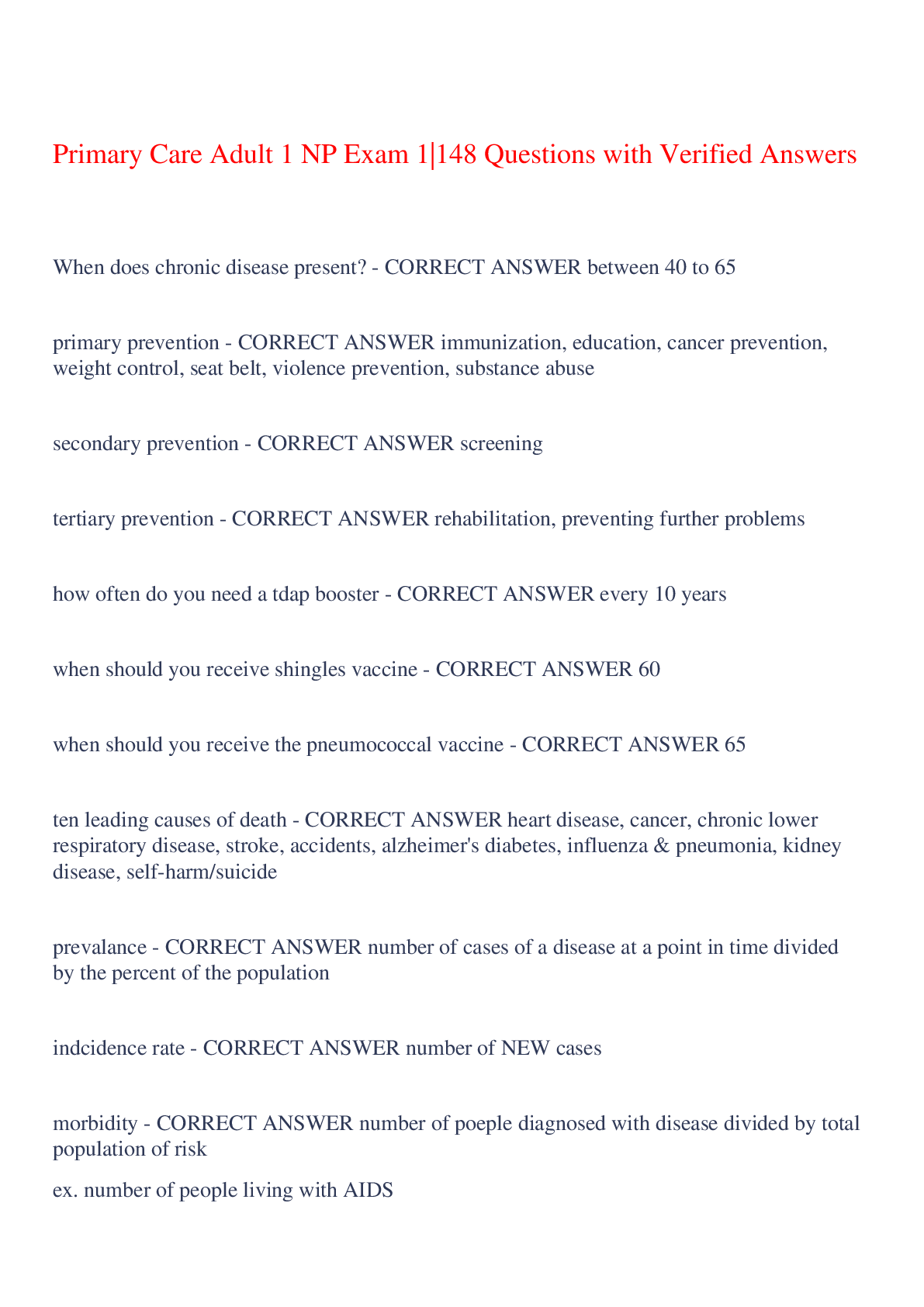
Reviews( 0 )
Document information
Connected school, study & course
About the document
Uploaded On
Nov 07, 2023
Number of pages
15
Written in
Additional information
This document has been written for:
Uploaded
Nov 07, 2023
Downloads
0
Views
95














